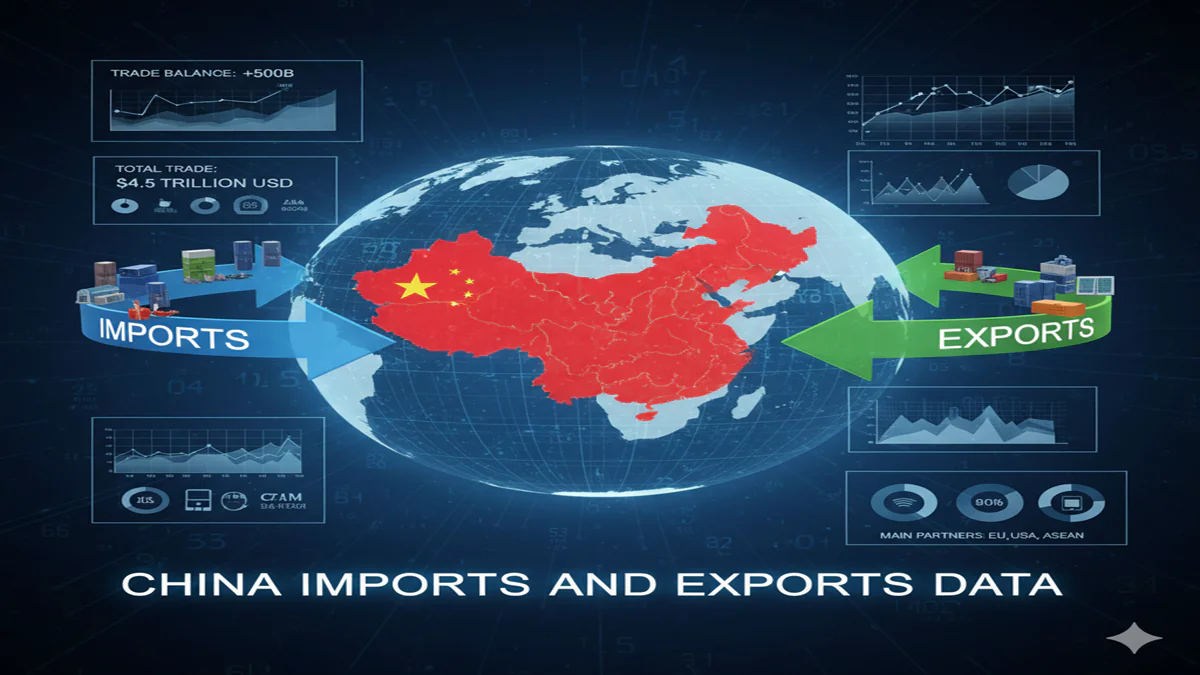China’s role in the global economy is underscored by its significant imports and exports, making it one of the largest trading nations in the world. As a vital hub for manufacturing and a key player in international trade, China’s trade data provides essential insights into its economic health and global market dynamics. This article delves into the latest statistics and trends regarding China’s trade, examining its major trading partners, the impact of global economic conditions, and the sectoral breakdown of goods traded. By analyzing these factors, we can better understand the complexities of China’s trade landscape and the implications for the future of global commerce.
China Imports And Exports Data
Overview of China’s Trade Landscape
Historical Context of Trade Development
China’s trade journey could easily be the plot of a blockbuster movie—lots of twists, turns, and a dramatic turning point. Starting from a closed-off economy in the late 20th century, China’s entry into the World Trade Organization in 2001 marked the beginning of a trade romance. Since then, it has transformed into the world’s largest exporter, with a smorgasbord of goods ranging from tech gadgets to textiles. The shift from a purely agricultural society to a manufacturing behemoth has solidified its role as a global trade powerhouse.
Current Trade Volume and Growth Trends
Fast forward to today, and China’s trade volume is like a hot air balloon—continuously rising, despite occasional turbulence. In recent years, the country has experienced steady growth in exports and imports, buoyed by strong demand for electronics and machinery. Even amidst a global pandemic and economic uncertainties, China’s knack for bouncing back has made its trade landscape one of the most dynamic in the world. Keep an eye on the numbers; they never lie—unless they’re from a game of poker.
Key Statistics on Imports and Exports
Total Import and Export Values
When it comes to sheer numbers, China is not shy about flaunting its trade values. In 2022 alone, China’s total trade value crossed the jaw-dropping mark of $6 trillion. That’s trillion with a ‘T’, my friend! Exports typically take the larger slice of the pie, but imports have been catching up, making for a deliciously balanced trade story.
Year-on-Year Growth Rates
Year-on-year growth rates have been a rollercoaster ride, with some years skyrocketing due to booming demand, while others face hiccups from various global events. Recent data shows that, despite the ups and downs, China’s trade growth remains robust, averaging around 4-6% annually. So yes, while there are bumps along the way, China’s trade journey continues to ascend steadily.
Trade Surplus and Deficit Analysis
Ah, the ever-controversial trade surplus—it’s like the cherry on top of China’s economic sundae. With a trade surplus that has been a consistent feature in its economic narrative, China finds itself on the winning side of the trade balance. However, there are instances of trade deficits in specific sectors, reflecting the complexities of global trade dynamics. It’s a fascinating dance of numbers, where some sectors are swimming in surplus while others are just treading water.
Major Trading Partners of China
Top Import Partners
China’s shopping list for imports reads like a who’s who of global economies. The United States, Japan, and South Korea are among its top import partners, supplying everything from raw materials to advanced technology. As China continues to bolster its domestic industries, these partnerships are crucial, ensuring that the country has the right ingredients for its economic recipe.
Top Export Partners
When it comes to exports, China is the belle of the ball, with its biggest dance partners being the United States, the European Union, and ASEAN nations. These regions collectively account for a hefty percentage of China’s exports, particularly in electronics, machinery, and textiles. It’s a trade relationship seasoned with mutual benefits, where China plays the role of a reliable supplier, and the world reaps the rewards.
Regional Trade Dynamics
Regions play a pivotal role in shaping China’s trade dynamics. The Belt and Road Initiative has turned many neighboring countries into strong trade allies, creating an intricate web of connections across Asia, Africa, and beyond. The dynamics shift constantly—a new trade agreement here, a tariff tweak there—but one thing remains constant: China’s regional trade influence continues to grow like a well-watered plant.
Impact of Global Economic Trends on Trade
Effects of Trade Wars and Tariffs
Trade wars are like the dark clouds looming over a sunny day in the trade world. The U.S.-China trade tensions have introduced tariffs that made goods more expensive and forced both countries to rethink their strategies. While China has taken hits, it has also been quick to pivot, seeking new markets and adjusting its supply chains. After all, when life gives you lemons, you make lemonade—or in this case, a new trade deal.
Influence of Global Supply Chain Disruptions
Remember the pandemic? Yeah, that little hiccup caused quite a jolt in the global supply chain, and China felt the tremors. With many companies relying on China’s manufacturing prowess, any disruptions can send ripples throughout the economy. The silver lining? It’s pushed China to diversify its supply chains and innovate, ensuring it’s not caught off guard in the future.
Impact of Currency Fluctuations
The yuan’s value can sway like a pendulum, influencing China’s trade competitiveness. A stronger yuan makes exports pricier for foreign buyers, while a weaker one can make imports more expensive. Navigating these currency fluctuations is like walking a tightrope, requiring constant balancing acts to ensure trade remains profitable. It’s a thrilling ride for traders and economists alike!
Sectoral Analysis of Import and Export Goods
Key Export Categories
China’s export landscape is dominated by electronics, machinery, and textiles. No surprise there! Electronics, particularly smartphones, computers, and components, account for a hefty chunk of exports, making China the go-to source for tech gadgets. Machinery is another heavyweight—think everything from construction equipment to small appliances. Let’s not forget textiles, which keep the supply chains buzzing with shirts, socks, and everything in between. Toss in a sprinkle of automobiles and you’ve got a recipe for export success!
Major Import Categories
When it comes to imports, China plays a game of catch-up with raw materials and energy. Crude oil tops the list—it’s like the fuel that powers the economic engine. Then there’s iron ore and copper, essential for manufacturing and construction. While China churns out stuff for the world, it needs these imports to keep factories humming. Other notable mentions include agricultural products, where soybeans and cotton find their way into Chinese markets to feed the domestic appetite.
Emerging Sectors in Trade
Keep an eye on the horizon, because new sectors are stepping onto the trade stage! Green technology is taking the spotlight, with solar panels and electric vehicle components leading the charge. E-commerce is another exciting avenue, as digital platforms expand their reach both in exports and imports. Don’t overlook health products and pharmaceuticals, which have gained traction, especially post-pandemic. These emerging areas could very well redefine China’s trade equilibrium in the coming years!
Trade Policies and Regulations Affecting China
Overview of Current Trade Policies
China’s trade policies are as dynamic as a ping-pong match—fast-paced and full of twists! Currently, the government is focused on stabilizing trade relationships while promoting self-reliance. Recent tariffs and trade agreements have aimed at balancing the scales with major trading partners. Think of these policies as the rules of the game, which can change based on the powers-that-be. With an eye on innovation, China is also incentivizing high-tech industries, hoping to keep the global competition on its toes.
Compliance and Regulatory Challenges
Navigating the compliance landscape in China is like threading a needle while riding a rollercoaster—challenging! Regulatory hurdles are ever-present, ranging from stringent quality control standards to environmental regulations that can give businesses headaches. Companies need to be on their toes to avoid fines and ensure smooth sailing through the regulatory framework. Plus, with constant changes, staying updated is not just advisable; it’s essential for survival in the trade game.
Impact of International Agreements
International trade agreements are like the secret sauces that can make or break trade relations. For China, agreements like the Regional Comprehensive Economic Partnership (RCEP) and partnerships with the European Union offer new avenues for trade and investment. These agreements promote tariff reductions and enhance cooperation in various sectors. However, they also come with strings attached—businesses must adapt to new standards and expectations. The balance of power can shift with these agreements, making them key chess pieces in the global trade strategy.
Future Projections for China’s Trade Balance
Forecasting Trends in Imports and Exports
Looking into the crystal ball, forecasts suggest that China’s exports will continue to rise as global demand for technology and consumer goods remains strong. Imports are also expected to grow, driven by the need for raw materials and energy resources as domestic consumption increases. The trade balance might experience some fluctuations, but overall a trajectory towards growth seems likely, barring any unforeseen global hiccups.
Potential Challenges Ahead
However, it’s not all sunshine and rainbows—challenges lurk around the corner! Geopolitical tensions, trade wars, and fluctuating demand could pose significant risks. Supply chain disruptions (thanks, pandemic!) are still fresh in everyone’s minds. Plus, as countries push for sustainability, China might face pressure to adapt its trade practices, and that could complicate things a bit.
Opportunities for Growth and Expansion
On the bright side, there are plenty of opportunities ripe for the picking! Expanding into untapped markets, especially in developing countries, could open new doors. Investment in green tech and digital transformation promises innovation and future-proofing. Plus, as e-commerce continues to flourish, online platforms could become the new trade frontiers for China.
With the right strategies, the future can look bright—even if the road ahead might have a few bumps!In conclusion, China’s imports and exports play a crucial role in shaping the global economy, reflecting the nation’s economic strengths and challenges. As the world continues to evolve, understanding the dynamics of China’s trade will be essential for businesses, policymakers, and economists alike. By keeping a close eye on trends, trading partners, and regulatory changes, stakeholders can navigate the complexities of this vital market and capitalize on emerging opportunities in the years to come.
Frequently Asked Questions
What are the main goods that China exports?
China primarily exports electronics, machinery, textiles, and furniture, alongside a growing number of higher-value products such as automobiles and technology components.
Who are China’s largest trading partners?
China’s largest trading partners include the United States, the European Union, Japan, South Korea, and Australia, among others, with varying degrees of import and export volumes.
How do trade policies affect China’s exports?
Trade policies, including tariffs and trade agreements, can significantly impact China’s exports by either facilitating market access or imposing barriers that can restrict trade flows.
What trends are expected to influence China’s trade in the future?
Future trends affecting China’s trade include advancements in technology, shifts in global supply chains, changes in consumer demand, and the ongoing effects of geopolitical tensions and trade agreements.

